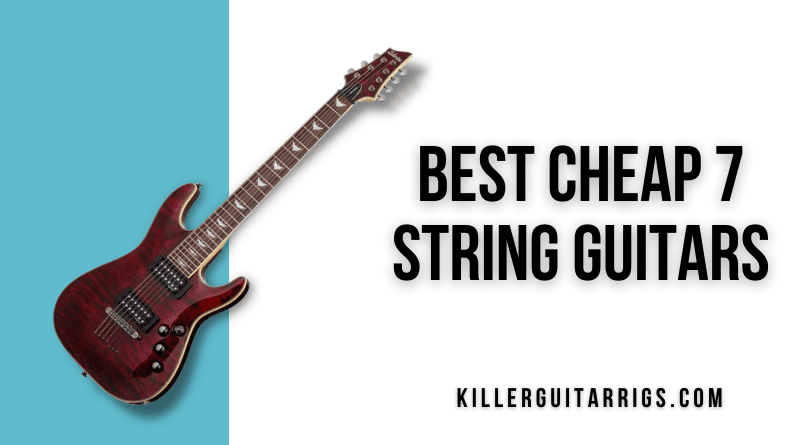The six-string guitar has been ‘king of the hill’ as far as guitars go, pretty much since the instrument has evolved into its modern form. There’s nothing that has really influenced the guitar-playing community to radically reshape all that the instrument has the potential to be.
Over the past few decades, a true alternative has come into light that offers a significant difference to that ‘same old same old’ – the 7-string guitar. Since they came on the scene, countless bands have used them to extend the range of what the instrument can do. That typically means being able to use lower tunings with a basement-bottom low end that is a hallmark of most modern metal.
For those players that are new to the concept, there typically are a lot of questions that need to be asked:
- ‘What should I look for in a 7 string?’
- ‘Are there any particular models that tend to rise above the others in the pack?’
- And – here’s most likely one of the most important ones – ‘how much do they cost, and can I really afford one that isn’t a piece of junk?!?’
Fear not – we have your back! In this roundup, we are going to take a look at a selection of impressive guitars, all with an average street price of under $500.
Read more about our review process.
You may also like
- Ultimate Les Paul Upgrade Guide
- What Is Agathis Wood And Why Is It So Hated?
- Gibson VOS – The Golden Age Experience
- 10 Best Delay Pedals – With Buyer’s Guide
Contents
Our Top 3
Our Top Pick is – without any doubt – the Jackson Dinky JS22-7. Coming in at under $200, you might think right off the bat that this thing must not be worth a broken guitar string, right? Well, we’re here to tell you that certainly is not the case. We were completely blown away by the JS22-7 – it’s a very impressive guitar with a smooth level of playability along with some great tone to boot. Don’t let the low price fool you – this guitar can be to the 7-string market what a good Fender Squier Strat can be to the vintage 6 string crowd: a diamond in the rough.
One other piece of advice we have: you shouldn’t overlook the used market. Countless players have scored incredible deals on amazing pieces of gear, all for much less than what you’d pay for when buying new. Sure, they may have a little wear and tear on them, but you can write that off to it having some ‘character’ and getting one that’s already worn in. In this regard, we don’t think you can really do much better with a used 7-string than the Ibanez RG7321. It was considered a workhorse back in the day, and you can find them relatively cheap out on the used market (they are no longer in production). The RG7321 had solid build quality, great hardware, and was rugged enough to endure even the most intense shredding. If your budget is a factor (which it is for most people), the RG7321 may be the perfect addition to your stable.
A Brief History of 7 String Guitars
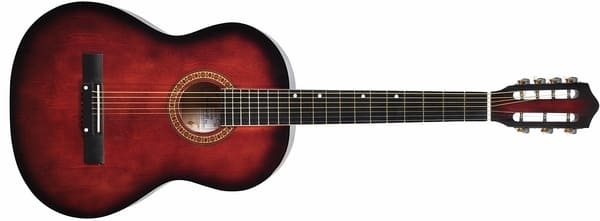
Seven string guitars actually go back to the 19th century, with Russian acoustics known as semistrunnaya gitara in wide use. The first widely known seven string guitarist in the US was George Van Eps whose 1968 custom Gretsch 7 string is thought to be the first signature seven string guitar.
However, it was Steve Vai’s 1990 signature Universe that really kicked things off for the mass-produced, widely available seven string. Vai took Ibanez’s RG series template and added a seventh string to be tuned down to B in standard tuning.
This was then picked up by a generation that would invent what was known as nu-metal, with Korn’s 1994 self-titled album (released just as the Universe was discontinued) extensively using extended range string guitars, tuning the first six strings in D standard and dropping the seventh to an A, bringing a heaviness to metal that arguably hadn’t been heard before.
Later bands like Meshuggah and Dream Theater would use these guitars to bring the technicality and staccato riffs that would redefine progressive music from the keyboards and soundscapes of the 80s and 90s to the low-tuned DJENT-inspired music scene that flourished thanks to bands like Periphery and Animals as leaders.
These days, pretty much any regular music store that carries electric guitars will have at least a few models, and with that wide availability comes a multitude of budget options from manufacturers such as Jackson, Ibanez, and ESP that are every bit as good as the more expensive instruments from 20 years ago.
Individual Reviews – New Models
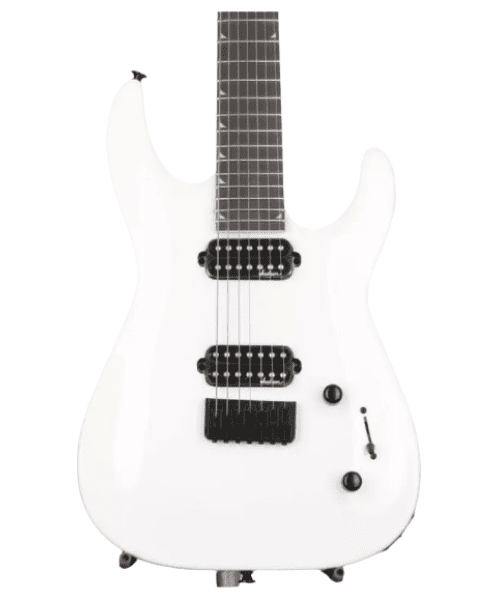
Jackson JS32-7 DKA Dinky HT
Killer styling and hot pickups make this a serious metal weapon.
This is a comfortable choice thanks to the arched top, and it offers fantastic tuning stability with its hard tail bridge design
Body: Poplar | Neck: Maple | Scale: 26.5” | Fingerboard: Amaranth | Frets: 24 | Pickups: Jackson High-Output 7-String humbucker (neck and bridge) | Hardware: Jackson HT7 hardtail, black | Finish: Satin Black | Left-handed: No
Jackson have always made amazing metal guitars, and these days, they not only make some of the most well regarded seven string guitars, they also make some killer options in the budget price range.
The JD22-7 has hot pickups, strings that go straight after the nut (which is great for tuning stability), and a contour cut for high-string access.
It has a really comfortable maple neck, and the arched top makes it overall a really enjoyable guitar to play.
Plus, at around $200, you have a ton of money left over to swap out the pickups for something to make the guitar really shine, such as the Fishman Fluence Signature Series Tosin Abasi set (check out reviews on Amazon here).
Really, the JD22-7 is a fantastic option for a first or budget seven string.
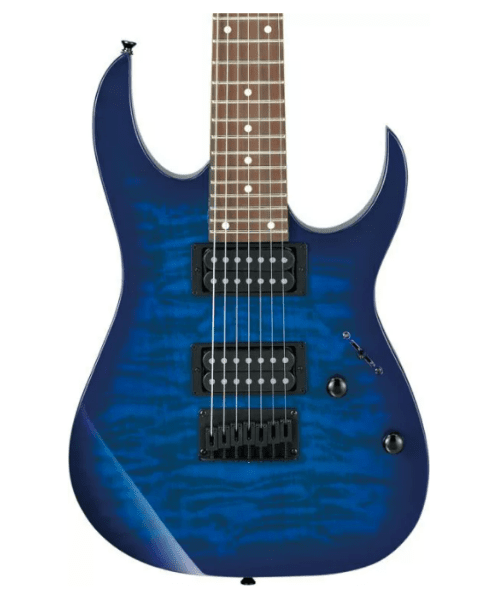
Ibanez Gio GRG7221QA
A gorgeous flamed top and a fast neck on this super shredder.
With this guitar you're getting an inexpensive shredder with a great finish and hot pickups that are perfect for overdriven, high gain tones
Body: Poplar with quilted maple veneer | Neck: Maple, bolt-on | Scale: 26.5” | Fingerboard: Treated New Zealand pine | Frets: 24, jumbo | Pickups: 2x Infinity R humbuckers (neck and bridge) | Hardware: F107 hard-tail bridge | Finish: Transparent Blue Burst, Transparent Black Burst | Left-handed: No
Stepping a little up in price, we see our first Ibanez on the list. Ibanez make several of the very best upscale extended range guitars on the market, but they also keep an eye on those looking to keep it cheap.
The GRG7221 is a stunner with the quilted maple top veneer, plus great pickups and a really comfortable neck.
You’re also getting a five-way switch, giving you a number of extra tonal possibilities. The pickups in this are great, but there’s money left over for an upgrade if you wish, such as to the Seymour Duncan Jeff Loomis Blackout 7-String set (check out reviews on Amazon here).
In addition to the above, it stays in tune like a king!
Really, for the extra $50 over our openers, you get a ton more guitar but a little less money for mods. Overall, a contender for #1, slightly edged out by the Dinky.
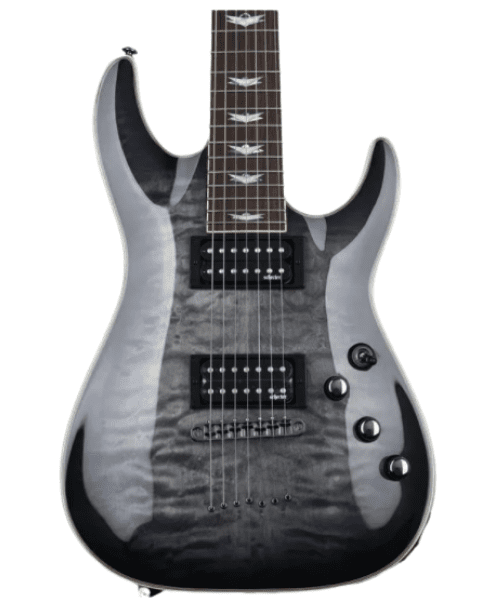
Schecter Omen Extreme 7
String through performance and exceptional fit and finish.
In the Omen Extreme-7, Schecter has created wht is easily one of the best looking 7 string models on the market. It offers incredible sustain, high output humbuckers that handle drop tunings brilliantly.
Body: Basswood, quilted maple top | Neck: Maple | Scale: 26.5” | Fingerboard: Rosewood| Frets: 24 | Pickups: Schecter Diamond Plus Pickups | Hardware: Schecter Custom Hardtail | Finish: Satin Black, Vinatage White, Walnut Satin | Left-handed: Yes
With the Omen, you will not have any money for upgrades – but you might not need them.
The Omen features a beautiful bound body with a quilted maple top, attractive inlays, killer tuning stability (thanks to the Graph Tech XL Black Tusq nut), and a fast neck.
It also has a toggle for coil tapping, so you have a wide range of sounds available with only two pickups – and the pickups are killer, so you may not want to swap them out at all.
Really, the only downside here is that many find the bridge a little uncomfortable for palm muting, but that’s entirely a matter of preference.
Overall, a killer guitar that lives up to its price.

Harley Benton R-457MN WH Progressive Series Review
Body: Basswood | Neck: Maple | Scale: 25.5” | Fingerboard: Maple | Frets: 24 | Pickups: HB High Gain Pickups | Hardware: DLX bridge and die cast machine heads | Finish: White high gloss | Left-handed: No
At around $145, this is easily the cheapest guitar on this list – but incredibly, it punches significantly above its weight.
Of course, you do have to factor shipping (assuming you only buy this item), but at $68, you’re still getting a steal.
For your money, you get a very comfortable guitar with great tuning stability, contoured basswood body, comfortable maple neck, and maple fingerboard, plus great pickups, with money left over for new pickups such as the Seymour Duncan M Holcomb Alpha Omega Set (check out the reviews on Amazon here).
The only downside is that many say their guitar needed a little work to make it fully playable, and if you do have any issues, you’ll need to send the guitar all the way back to Europe.
However, if you want to take a minor chance, you’re rewarded with a major deal.
Note: also available as a fan fret for an extra $30 (check that out here).
Individual Reviews – Used Models
If you’re really looking for the best deal on a 7-string and don’t mind dealing with the second-hand market, we recommend the following four guitars from the used market.
Ibanez RG7321 Review

Body: Basswood | Neck: Maple/Walnut | Scale: 25.5” | Fingerboard: Rosewood W/Binding| Frets: 24 | Pickups: Ibanez AH2-7 and AH1-7 | Hardware: Jackson hardtail, black | Finish: Black | Left-handed: No
This is easily our number one used choice, especially as you can often get them as low as $250 on Reverb or Ebay.
The RG7321 has been the first seven string of choice for countless players for 20 years now. Despite being out of production for a few years, ask any online group for a suggestion, and you will get the RG7321 thrown at you again and again.
Part of the reason for this is the Ibanez Wizard neck is comfortable, and the hardware is excellent – the bridge, nut, and tuners are all great out of the gate.
The guitar’s only weak point is the pickups, but at $250 – $300 used, you have $200 leftover for something like the Seymour Duncan Nazgul/Sentient Set (check out the reviews on Amazon here).
Ibanez RG7420 Review

Body: Basswood/Mahogony | Neck: Maple/Walnut | Scale: 25.5” | Fingerboard: Rosewood | Frets: 24 | Pickups: Depending on year, the AH-7 set or the QM7 set from Ibanez| Hardware: Jackson Edge Zero II-7 or STD Dl depending on year | Finish: Black, White, Walnut | Left-handed: No
The RG7420 can typically be found on Reverb for between $300 and $500 depending on condition and has many of the same plus points as the RG7321 in addition to having a Floyd Rose style tremolo system in the bridge.
For your money, you also get slightly better tuners, a locking nut, and much-improved pickups – plus, if you’re a Floyd Rose fan, you’ll enjoy the Edge Zero tremolo system for all your dive bombing needs!
However, depending on the condition of the guitar you end up with, you won’t have change from $500 for upgrades – but you may well not need it.
Schecter C7 Hellraiser Review

Body: Mahogany | Neck: Mahogony | Scale: 26.5” | Fingerboard: Rosewood | Frets: 24 | Pickups: EMG 707TW set | Hardware: TonePros 7-String TOM w/ String Thru Body| Finish: Gloss White, Black Cherry, Gloss Black. | Left-handed: No
The C7 Hellraiser typically retails in the $900 range, but with some patience and some haggling, they can be found for $500.
For your money, you’re getting a really killer guitar. The C7 looks amazing, has great definition due to the extended 26.5″ scale, and the coil-splitting actually kicks out a lot of very useable tones, from jazzy cleans to face-melting metal bite courtesy of the EMG 707TW active pickups.
The neck also sports a slim C-profile that fits very comfortably in the hand, unlike some more beefy options. The mahogany body is contoured to make for a super comfortable playing experience.
While it may take a little time to track one down at $500, you may find you never need another.
ESP LTD MH-417 Review

Body: Mahogony | Neck: Maple | Scale: 25.5” | Fingerboard: Pau Ferro | Frets: 24 | Pickups: EMG 85-7H and 81-7H | Hardware: TOM w/ String Thru, Grover Tuners | Finish: Satin Black | Left-handed: No
ESP LTD make many of the best metal guitars on the market, especially at a lower price point. If you’re looking at sub $1000 seven strings, you’ll find LTD popping up again and again, with a wide range of options for passive or active pickups, solid bodies or maple tops, different scale lengths, and so forth.
Looking in the sub $500 used market, the best you’re going to get for your money is the ESP LTD MH-417. These retail for around $900 but are on Reverb for $500 all the time.
You’ll notice as we’ve stepped up more towards high-end guitars, we’re seeing much better woods, going from basswood to mahogany. The MH-417 kicks things up a notch with a Pau Ferro fingerboard, in addition to the awesome EMG 85 81 set and awesome Grover tuners. Maybe not all the way into John Petrucci or Steve Vai territory, but you’re getting a lot of high-end appointments here for under $500.
Sound-wise, the active pickups give you a ton of bite for sharp and articulate low notes and clear high tones.
Really, this is the best you’re going to get for $500 – especially for metal players. The buck stops here!
How To Choose The Right Guitar For You
If you’re new to seven-string guitars, there are a number of things you need to be aware of to make sure you get the right guitar for what you want to do.
Scale Length
Most seven string guitars fall between 24.5 and 25.5 inches, but if you want to tune your guitar down significantly, you may need to seek out a longer scale length.
The “standard” range of around 25 inches is fine if you want to play standard E with a drop B or A, but if you’re looking to extend to standard D with an A or G, or even lower to a tuning like low E on the 7th string, you’ll want to look into a guitar with a longer scale length.
The effect of tuning super low on a 24.5 or 25.5 scale guitar will be that your lower strings will lose tension and can go sharp when struck (which bands such as Fit For An Autopsy have sometimes used as a feature). You can get around this by fitting a heavier gauge string, but many will want to find a comfortable balance between the two to allow fast playing at lower tunings.
Multi Scale or Fanned Fret Guitars
Multi-scale guitars, also known as fanned fret guitars due to the look of the frets, are where the nut, bridge, frets, and sometimes pickups are all installed at varying angles instead of just being perpendicular to the strings all the way down.
The benefit of this is that you can have a shorter scale length on the high strings and a lower scale length on the low strings. This means you can have that slinky feeling where you need to solo and tight feeling where you need to chug, with the added benefit of reliable intonation for the low strings, which is often a battle with cheaper guitars.
Of course, fan frets vary quite a bit from model to model, but typically you’re looking at a 25.5-inch scale length on the treble side and 27 inches on the bass side, with some eight strings stretching up to 28 inches on the bass side, though this makes it much harder to play evenly, more so than other extended range guitars.
Nut Width
Many seven-string guitars opt for a wider neck and a wider nut to facilitate the extra string – that way, players won’t find themselves struggling with a crowded neck, particularly on the first fret.
However, there are some manufacturers (such as ESP and Caparison) who have a narrow 42mm or 43mm nut width, roughly what you would have for a six-string.
On the other end of the scale, some seven-string models will come with 50mm or wider nuts, which will prove challenging for players with smaller hands.
For this reason, it is vital when comparing seven-string models to look at the nut width on spec sheets and, if at all possible, play before you buy to get an idea of whether the guitar will fit your hands.
If you’re looking to have a similar string spacing to a 6 string, make sure to look for a guitar with a nut width of around 47 to 48mm. If you’re planning on tuning super low and thus using some thick bass strings, look for something more in the 49 to 51mm range.
Neck Profile
The thing to watch out for here, especially with budget seven-string guitars, is a neck so thin it may not stay in tune.
Cheaper instruments that aim for a flat, thin neck profile may use inferior materials and processes that do not provide the support to the neck necessary for solid tuning stability. This results in a neck that bends easily when playing hard and inconsistent and unreliable tuning stability. This becomes more apparent when you move into cheaper guitars with longer scale lengths.
The best way to check for this is to strum the open strings and then lightly press on the back of the headstock. Any guitar will have some give here, but you want to look out for guitars that quickly detune with only a small amount of pressure.
Owner’s Guide
If you’re new to 7, 8, 9 or even 10 string guitars, you’ll need to make certain adjustments to how you set up and play. Here are some of the key takeaways we feel will get you through the first few months and make your instrument the best it can be (check our choices for best 7 string here).
String Gauge
When choosing strings, you want to be very mindful of your scale length, your desired tuning, and your guitar’s nut (read our full guide to guitar strings here).
If you’re going to A, G, or even all the way to E, you might want to buy a seven string set with a low string bigger than .060 inches. Many will purchase a regular six-string set and then buy the seventh string separately.
For example, Patrick Sheridan of Fit For An Autopsy runs his first six strings as a set of Ernie Ball 10-52s and then puts a .068 or .074 on his low string, depending on the tuning.
Also, when picking a lower string, you will want to make sure to check that the nut on your guitar is set up to handle a thick string – or you may find yourself with buzzing, or worse yet, the string popping out.
As always, our advice is to take your new guitar, as you would with any, to a local luthier and talk through your options.
Tuning
The most popular tuning is to keep your regular standard E tuning, plus add a low B on the bottom (B-E-A-D-G-B-E), or drop the low string to A (A-E-A-D-G-B-E).
However, if you check out some of your favorite artists, you’ll see everything from open tunings to having the guitar in standard C with a low G or F.
However, bear in mind that your guitar, either due to scale length or thin nut, may not be able to reach these low tunings – this is why seven strings need to have strong necks. You may also find your strings need to be updated to thicker strings for thicker tones.
As always, do your research, ask questions, spend your money where it matters, and have fun.
You may also like

